Ramsey Wireless Winch
No more standing in mud, snow or water to winch out--just use the wireless remote from behind the steering wheel or behind the tree.
| • Chevy and GMC 4x4 • |
As I've said before--see “Skyjacked Suburban” in the September 2003 issue--four-wheel-drive Suburbans, especially the 1973 through 1987 models--are my favorite dual-sport vehicles. They make excellent daily drivers, they can easily tow your trailer or boat, and once they've been prepped a bit with tires and suspension mods, they're really fun to drive regardless of whether you're on the road or off. Suburbans can carry your family, all your supplies, and all your gear for extended stays in the outback. Drop the second row seats, throw in a mattress, and they become a comfortable camper. I prefer tailgate models, but even with barn doors a Suburban is hard to beat as a DSUV--dual-sport utility vehicle.
My favorite models (1973 through 1987); however,
do have one drawback. They're getting a bit long in the tooth, which means they're getting old. It also means that most of the aftermarket accessory manufacturers have moved on to more modern SUVs and no longer offer products for this age group.
This is unfortunate, too, for both the owners and the suppliers, because when you count up the numbers involved, they are staggering. With minor modifications, the same products can be used on Suburbans, Blazers (and Jimmies), and pickups. That's a lot of vehicles. Anyway, after adding the Skyjacker suspension and ProComp wheels and tires, I began planning the next phase--a swing-away spare tire carrier (the 10-inch-wide, 35-inch-tall tire was too big for the inside spare tire location), a winch, and supplemental lighting for those late-night tows into a campsite.
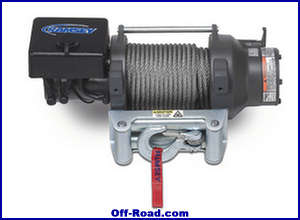 With Ramsey introducing a newly designed winch rated at 15,000 pounds--it’s always a good idea to pick a winch for your vehicle that has a rating that is at least double the weight of your vehicle--in addition to its 12,000-pound model, I had to have it!
With Ramsey introducing a newly designed winch rated at 15,000 pounds--it’s always a good idea to pick a winch for your vehicle that has a rating that is at least double the weight of your vehicle--in addition to its 12,000-pound model, I had to have it!
When I found out that I could add a wireless remote to the Patriot, I was hooked (no pun intended). I had picked the winch, and I had chosen Hella lights for the supplemental lighting, but I couldn't find a supplier for a swing-away tire carrier or for a grille guard that did double duty as a winch mount. I could have had something custom-made, but I didn't really want to pay someone to experiment on my vehicle with their first products. I decided to do an Internet search and see what happened. I discovered Kennesaw Mountain Accessories (770-947-0190, 8858 Brightstar Road, Suite C, Douglasville, Georgia 30134; www.kenmtn.com), which seemed to have a huge selection from which I could choose. I choose the Wincher and the Multi-Carrier. The Wincher, which is a front bumper with integrated grille guard, starts at about $600. You then tell them what you want added; i.e., trailer hitch receiver, tow points, light mounts, etc.
The Multi-Carrier, which is a rear bumper with built-in tire carrier, also starts at about $600.
Again, you chose the add-ons; i.e., tow points, license plate holder, trailer hitch receiver, Hi-Lift Jack mounts, etc. While Kennesaw Mountain was the only company I could find that offered what I wanted, be sure this is the way you want to go. The company's products are expensive and they are heavy, which means the products are extremely expensive to ship and you'll need help installing them. Since I live in Arizona and Kennesaw Mountain is in Georgia, it cost more than $250 just for shipping, and the shipping company wouldn't deliver the bumpers to my
house. I had to drive to company's nearest warehouse (about a 75-mile roundtrip) to pick up the items. Anyway, this would have all been worth it if the products had been built to my specifications and had fit my ’87 Suburban without
modifications, but they weren’t and they didn’t. 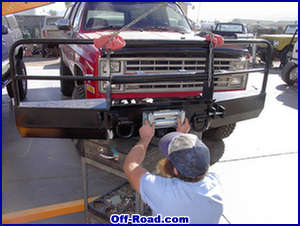 To begin
with, I sent dimensions and digital pictures for the tow bar
brackets I wanted installed on the front bumper. They were welded
on more than an inch too wide, so now I have to find longer pins.
To begin
with, I sent dimensions and digital pictures for the tow bar
brackets I wanted installed on the front bumper. They were welded
on more than an inch too wide, so now I have to find longer pins.
Next, according to the installation instructions, all you have to
do is hold the front bumper in position with its mounting brackets
alongside the Suburban’s frame rails. Drill the mounting
holes through the bumper’s brackets to match the
factory-punched holes in the frame rails. Well this wouldn’t
work with the Wincher Kennesaw sent me; the mounting brackets were
welded into place on the wrong side of their marks. The brackets
were the same distance apart as the frame rails, so they had to be
cut out and rewelded into their proper places. It took the shop
(Precision Automotive, 928-757-7273, 2325 Northern Avenue, Kingman,
AZ 86401) five hours to install the front bumper because it had to
be reconfigured before it could be mounted. (Even the built-in
winch mount had to be corrected and strengthened by the shop owner,
Paul Schupp, because the pre-drilled winch mounting holes were
drilled in such a manner as to make the winch face the wrong
direction.) 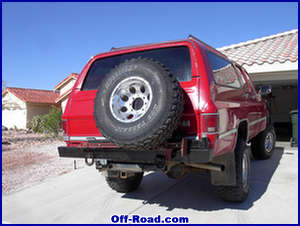 Mounting the rear bumper took just the one hour
forecasted by Kennesaw’s instructions. The first step was to
cut off approximately 3 inches of the rear frame rails. This allows
the Multi-Carrier rear bumper to be positioned in closely to the
Suburban’s tailgate. As I said, the rear bumper went on slick
as a greased pig, and really looks good.
Mounting the rear bumper took just the one hour
forecasted by Kennesaw’s instructions. The first step was to
cut off approximately 3 inches of the rear frame rails. This allows
the Multi-Carrier rear bumper to be positioned in closely to the
Suburban’s tailgate. As I said, the rear bumper went on slick
as a greased pig, and really looks good.
The swing-away tire
carrier easily carries the heavy spare tire, the bumper and the
tire carrier clear the tailgate with plenty of room when the
tailgate is dropped, and the bumper doesn’t interfere with
the factory trailer hitch receiver. However, I had to bend the
bolts used for the Hi-Lift jack mounts because they didn’t
line up with the holes in the jack’s shaft, and no license
mount was included, either. 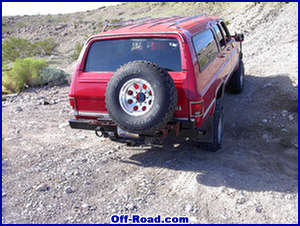 Because of the weight on the Wincher
(approximately 150 pounds) and the Ramsey winch (another 120
pounds), and the weight of the rear bumper, tire carrier, spare
tire, and Hi-Lift jack (about 250 - 300 pounds), I decided not to
cause the Skyjacker Softride suspension to sag.
Because of the weight on the Wincher
(approximately 150 pounds) and the Ramsey winch (another 120
pounds), and the weight of the rear bumper, tire carrier, spare
tire, and Hi-Lift jack (about 250 - 300 pounds), I decided not to
cause the Skyjacker Softride suspension to sag.
The suspension is designed for giving a comfortable, soft ride while carrying stock weight with temporary additional weight such as gear, people, trailers, etc., but it is not designed to carry nearly 600 pounds constantly without suffering in the ride department or possibly sagging a bit. Since the 35-inch tires were already coming in contact with the front fender in certain off-road conditions, I wanted to maintain the ride height and comfort as much as possible.
Interestingly enough, Big Red had already settled onto its
suspension about 1-1/2 inches after seeing slightly more than a
year of Arizona highways, byways, and some very technical trails. I
asked Skyjacker for a set of helper leaves, which turned out to be
one more leaf for each corner. Now, with everything installed, Big
Red is right back at the same height it exhibited originally
immediately following the suspension installation (44 inches to the
center for both front fender wells and 42 inches to both rear
openings). The ride is a bit stiffer with the additional leaves but
not uncomfortably so, just slightly more solid feeling. 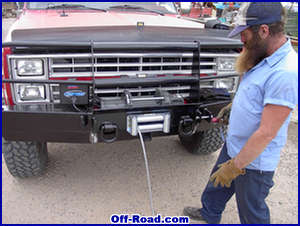 Anyway, once the
two bumpers were installed, the remaining installation went
swimmingly. The Ramsey Patriot 15000 (Ramsey Winch, 918-438-2760,
P.O. Box 581510, Tulsa, OK 74158, www.ramsey.com) mounts in a standard four-hole
pattern, and the roller fairlead bolts to the front. It is equipped
with a 5.5-hp 12-VDC reversible motor so that you can winch
yourself up or out of an obstacle or down an extremely steep
incline.
Anyway, once the
two bumpers were installed, the remaining installation went
swimmingly. The Ramsey Patriot 15000 (Ramsey Winch, 918-438-2760,
P.O. Box 581510, Tulsa, OK 74158, www.ramsey.com) mounts in a standard four-hole
pattern, and the roller fairlead bolts to the front. It is equipped
with a 5.5-hp 12-VDC reversible motor so that you can winch
yourself up or out of an obstacle or down an extremely steep
incline.
As its name implies, it has a rate line pull of 15,000 pounds, its gear reduction ratio is 251:1, and it is equipped with 90 feet of 7/16-inch galvanized wire rope with a replaceable self-locking clevis hook. As most people know, a winch’s pull is rated from a bare capstan, well even with four layers of cable; the Patriot 15000 is still rated at a 9,000-pound pull. That’ll pull the 6,500-pound Suburban through Mississippi gumbo mud without a single complaint as long as the battery(s) is up to the task. And its line speed is a very fast 25 fpm with no line load, and a respectable 11 fpm with a 4,000-pound load. Not too shabby, huh? You’ll also notice in the pictures and the title of this article that I opted for the wireless remote on the Patriot. Designed for use with both Patriot and Patriot Profile models, the wireless remote goes on your key chain.
You no longer
have to get out and stand in mud or freezing snow to operate the
winch. The remote is weatherproof and has a fairly wide operational
range--I haven’t fully tested out this range as yet. It has
three buttons on it: on/off, in, and out. For safety’s sake,
the on switch has about a 3-second delay built into it so that you
don’t accidentally operate the winch without your knowledge.
You hold the switch down until its LED flashes, and then you merely
have the winch roll cable in or out. 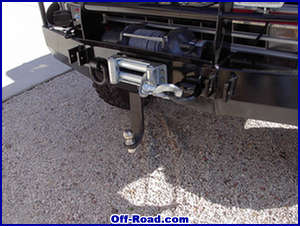 Mounted on the front bumper adjacent
to the Patriot is the control box. This same box is used for both
the wired and wireless remotes. It is connected to the winch motor
and directly to the wireless receiver, which is mounted near the
firewall. A short magnetic antenna (about 8 inches) picks up the
remote’s signals for the receiver, so you need to choose a
location for the antenna. I picked the passenger’s side front
fender well inside the engine compartment of the Suburban.
There’s plenty of room for it, however, I assume the
operational range may be affected by all the metal that surrounds
the antenna, but I haven’t noticed any signal degradation.
Mounted on the front bumper adjacent
to the Patriot is the control box. This same box is used for both
the wired and wireless remotes. It is connected to the winch motor
and directly to the wireless receiver, which is mounted near the
firewall. A short magnetic antenna (about 8 inches) picks up the
remote’s signals for the receiver, so you need to choose a
location for the antenna. I picked the passenger’s side front
fender well inside the engine compartment of the Suburban.
There’s plenty of room for it, however, I assume the
operational range may be affected by all the metal that surrounds
the antenna, but I haven’t noticed any signal degradation.
The Patriot’s heavy power cables are routed through Big Red’s grille and attached directly to the battery. (I’ll be adding a second battery in the next phase of Big Red’s construction.) With my tongue firmly planted in my cheek, about the only downside of Ramsey’s new Patriot 15000 model that I’ve found is the jealousy it generates within my trail buddies. They all want one! Even on relatively lightweight Jeeps. I’m really looking forward to the first time I get to use this on the trail.
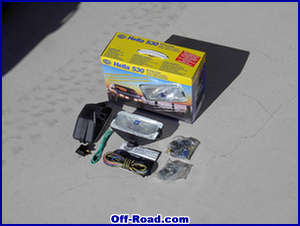 Lastly but not least, I installed a pair of
fog lights and pair of driving lights on the welded tabs Kennesaw
installed for me on the Wincher. The tabs were even located
correctly. I’ve worked with Hella (800-247-5924, www.hella.com) on
several other projects over the years and I’ve always been
thoroughly impressed by the design, effectiveness, and reliability
of the Hella products. I chose Hella’s model 550 fog (part
no. 74506) and driving (part no. 74406) light kits (the 550 fog
lights are available with clear or amber--part no. 74606--lenses, I
prefer a clear lens) because the kits include all the wiring,
relays, switches, and lights. Included with each kit is also a
wiring diagram. Both models use the same case, the same color-coded
wiring harness, and the same H3 55-watt halogen bulbs. The only
difference is in the lens design. The 550 driving light produces a
long, narrow beam for highway driving, and the 550 fog produces a
flat, wide-angle pattern to spread illumination close in to the
front of the vehicle for use in rain, snow, blowing dust, or fog
(the lens design greatly reduces reflected glare during bad
weather).
Lastly but not least, I installed a pair of
fog lights and pair of driving lights on the welded tabs Kennesaw
installed for me on the Wincher. The tabs were even located
correctly. I’ve worked with Hella (800-247-5924, www.hella.com) on
several other projects over the years and I’ve always been
thoroughly impressed by the design, effectiveness, and reliability
of the Hella products. I chose Hella’s model 550 fog (part
no. 74506) and driving (part no. 74406) light kits (the 550 fog
lights are available with clear or amber--part no. 74606--lenses, I
prefer a clear lens) because the kits include all the wiring,
relays, switches, and lights. Included with each kit is also a
wiring diagram. Both models use the same case, the same color-coded
wiring harness, and the same H3 55-watt halogen bulbs. The only
difference is in the lens design. The 550 driving light produces a
long, narrow beam for highway driving, and the 550 fog produces a
flat, wide-angle pattern to spread illumination close in to the
front of the vehicle for use in rain, snow, blowing dust, or fog
(the lens design greatly reduces reflected glare during bad
weather). 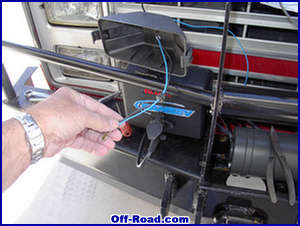 First step is to disconnect the ground side of the
battery (of course, you may already have the battery disconnected
if you’re installing the lights and winch at the same time).
You must assemble each light by running the black power and blue
ground wires through the weatherproof rubber grommet and connecting
them to the H3 bulb, as per the included instructions. The ground
must be connected to clean metal, preferably a part of the frame.
You then route black power wire to the #87 terminal on the relay
(you’ll also want to find a location for mounting the relay).
Route the yellow wire from the #86 relay terminal through the
firewall to the switch mounted in the dash. While you’re
there, route the green wire from the switch, through the firewall,
and connect via the solderless connection to a power wire for the
headlights. (Hella recommends green wire from the fog light switch
to low beams and the driving light wire to the high beam wire. This
will allow you to control use with the high/low beam switch.
However, since I like a lot of light, I attached the green wire to
the parking light circuit, that way I can have both fog and driving
lights on while my high beams are on, but the single light switch
on the dash will turn everything off at once.) A short blue wire
from #85 relay terminal must be grounded, and the 12-gauge red wire
from the #30 terminal is attached to the plus (+) side of the
battery. The lights can then be adjusted using a 11/16-inch wrench
or socket for side-to-side and a 10mm socket for up-and-down. The
Hella instructions explain how to do this.
First step is to disconnect the ground side of the
battery (of course, you may already have the battery disconnected
if you’re installing the lights and winch at the same time).
You must assemble each light by running the black power and blue
ground wires through the weatherproof rubber grommet and connecting
them to the H3 bulb, as per the included instructions. The ground
must be connected to clean metal, preferably a part of the frame.
You then route black power wire to the #87 terminal on the relay
(you’ll also want to find a location for mounting the relay).
Route the yellow wire from the #86 relay terminal through the
firewall to the switch mounted in the dash. While you’re
there, route the green wire from the switch, through the firewall,
and connect via the solderless connection to a power wire for the
headlights. (Hella recommends green wire from the fog light switch
to low beams and the driving light wire to the high beam wire. This
will allow you to control use with the high/low beam switch.
However, since I like a lot of light, I attached the green wire to
the parking light circuit, that way I can have both fog and driving
lights on while my high beams are on, but the single light switch
on the dash will turn everything off at once.) A short blue wire
from #85 relay terminal must be grounded, and the 12-gauge red wire
from the #30 terminal is attached to the plus (+) side of the
battery. The lights can then be adjusted using a 11/16-inch wrench
or socket for side-to-side and a 10mm socket for up-and-down. The
Hella instructions explain how to do this.
With the exception of mounting the bumpers, this is an easy install. However, it will take at least two people to mount the bumpers due to their weight. If you can find a front bumper that will accommodate the Ramsey Patriot 15000 and the Hella lights, you’ll find this a fun and easy upgrade. (By the way: the same winch and lights can be mounted on any truck, SUV, or four wheeler, not just a Suburban or GM-produced truck.)
| • Contact Information • |
Ramsey Winch
918-438-2760
P.O. Box 581510
Tulsa, OK 74158
www.ramsey.com
Hella
800-247-5924
www.hella.com
Kennesaw Mountain Accessories
770-947-0190
8858 Brightstar Road, Suite C
Douglasville, Georgia 30134
www.kenmtn.com
| • Chevy and GMC 4x4 • |
